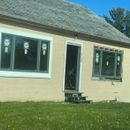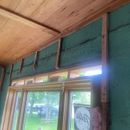Block wall exterior insulation and vinyl siding
Climate zone 5. Unfinished above ground block walls. I am converting a vacant building into a small dwelling. I want to buy some reclaimed Polyiso and install 3″, in some combination of thickness, but I am struggling with the placement of layers/furring strips (I suffer from paralysis of analysis). I plan to use vertical vinyl siding too. Also wondering if I should seal the block before covering it. I am also planning to fur out the interior wall, about 2 1/2″ and add some unfaced fiberglass. Replacing the existing windows and installing “outies”.
I found this to be surprising, from Johns Manville:
EXCEPTION: If vinyl siding is to be installed over AP Foil-Faced sheathing, install foam boards with the white nonreflective side toward the vinyl siding.
Technical Guide (d3i80q92llbc1d.cloudfront.net)
GBA Detail Library
A collection of one thousand construction details organized by climate and house part











Replies
If you used 2 x 1.5" layers of polyiso, with each layer taped / staggered, I don't seen much use in installing a separate WRB behind it for this type of application. The fluid applied WRB are expensive, and while attaching tyvec can be done fairly quickly with a ramset nail or masonry screw, I'm not sure what it would provide that the 3" of polyiso wouldn't.
As far as the furring strips go, I don't see why you couldn't do it a few ways, assuming you need the surface to be flush, and not air gapped for the vinyl install.
1. install horizontal 2x4's attached to the CMU. fill between with polyiso. Attach second layer of polyiso through to furring strips. Attach vinyl siding through second layer of polyiso into the horizontal furring.
2. (basically the same, but backwards) Install the first layer of polyiso with just enough screws or ramset nails to hold in place. Install horizontal furring 2 x 4's. Fill between with polyiso. Attach vertical siding to the 2x4's.
3. (more fussy, slightly higher R value) Use #2 with a 3/4" channel routed in the 2nd layer of polyiso, and use 1x4's instead of 2x4's to marginally increase the walls composite R value. I'm almost certain this isn't worth it in terms of effort and time, especially if you're insulating the interior as well.
I agree that taping the face of the iso will probably work fine for air&water control. In your climate, your stackup as described has some risk of condensation against the foil backing of the first layer of iso. That wouldn't do much damage though, just allow it to weep out the bottom of the stackup. In all likelihood, any condensation would be minimal. As always, air sealing is is still important. CMU walls are surprisingly leaky if not intentionally air sealed. This is an argument in favor of a liquid-applied WRB on the block. It would do double duty as air-seal and backup WRB. There are probably cheaper solutions for air sealing though, including careful blower door assisted air sealing while the block is exposed, either on the inside or outside.
The recommendation to put the non-reflective side out is probably a nod to the history of melted vinyl siding. The worry may be that reflected heat from the backside could raise the temperature of the vinyl enough to melt it. I'm not sure it really makes any difference though. The whole stackup would have to be tested to tell for sure. JM may already have done this testing. When in doubt, follow the manufacturer's instructions.